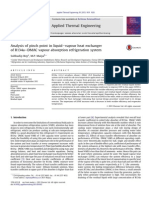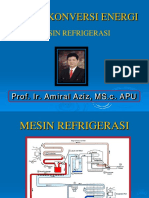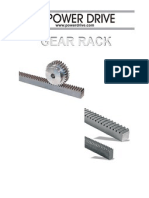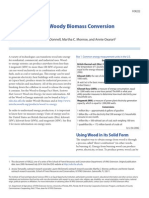Multiphase Simulation of Automotive Hvac Evaporator Using R134a and R1234yf Refrigerants
Multiphase Simulation of Automotive Hvac Evaporator Using R134a and R1234yf Refrigerants
Uploaded by
IAEME PublicationCopyright:
Available Formats
Multiphase Simulation of Automotive Hvac Evaporator Using R134a and R1234yf Refrigerants
Multiphase Simulation of Automotive Hvac Evaporator Using R134a and R1234yf Refrigerants
Uploaded by
IAEME PublicationOriginal Title
Copyright
Available Formats
Share this document
Did you find this document useful?
Is this content inappropriate?
Copyright:
Available Formats
Multiphase Simulation of Automotive Hvac Evaporator Using R134a and R1234yf Refrigerants
Multiphase Simulation of Automotive Hvac Evaporator Using R134a and R1234yf Refrigerants
Uploaded by
IAEME PublicationCopyright:
Available Formats
International Journal of Mechanical Engineering and Technology (IJMET)
Volume 8, Issue 2, February 2017, pp. 263270 Article ID: IJMET_08_02_032
Available online at http://www.iaeme.com/IJMET/issues.asp?JType=IJMET&VType=8&IType=2
ISSN Print: 0976-6340 and ISSN Online: 0976-6359
IAEME Publication
MULTIPHASE SIMULATION OF AUTOMOTIVE HVAC
EVAPORATOR USING R134A AND R1234YF
REFRIGERANTS
C.S. Rajamanickam
Student, Vellore Institute of Technology, VIT- University, SMBS, Chennai, Tamil Nadu, India
P. Tamilselvan
Associate Professor, Vellore Institute of Technology, VIT-University, SMBS, Vellore, Tamil Nadu, India
ABSTRACT
This paper presents a multiphase simulation of evaporator in automotive air conditioning
system was done by using R134a and R1234yf as working fluid (refrigerants) to know the
performance parameters. A CFD model was built to simulate the multiphase flow and the Thermal
analysis is carried out for the evaporator by using R134a and R1234yf refrigerants with constant
mass flow rate. The results obtained after the simulation are expressed in the figures of volumes
fraction, temperature, velocity of refrigerants. The CFD simulation was compared with both the
refrigerants. And it was also thus conforming that the CFD model was successful in reproducing
the heat and mass transfer process in HVAC evaporator using R134a and R1234yf refrigerants.
Key words: Multiphase, R134A, R1234yf, Thermal analysis, HVAC, Evaporator, Star ccm+.
Cite this Article: C.S. Rajamanickam and P. Tamilselvan. Multiphase Simulation of Automotive
HVAC Evaporator using R134A and R1234YF Refrigerants. International Journal of Mechanical
Engineering and Technology, 8(2), 2017, pp. 263270.
http://www.iaeme.com/ijmet/issues.asp?JType=IJMET&VType=8&IType=2
1. INTRODUCTION
Evaporator is one of the necessary components of HVAC system. The refrigerant can be considered as the
fifth most important component. The design of evaporator changes based on the application. And the
refrigerants used here absorb the amount of heat proportional to the latent heat of evaporator. This is
sufficient to change its phase from liquid to gas in the evaporator.
http://www.iaeme.com/IJMET/index.asp 263 editor@iaeme.com
Multiphase Simulation of Automotive HVAC Evaporator using R134A and R1234YF Refrigerants
Figure 1 Evaporator Flow chat
In the evaporator, the refrigerant is evaporated by the heat transferred from the heat source. The heat
source will be a gas during evaporation, the Temperature of a pure refrigerant is constant, as long as the
pressure does not change.
1.2. Vapour Compression Cycle
The system uses refrigerants like R-11, R12, R22, R134a. The system mainly consists of four parts
Compressor, Condenser, thermal Expansion Valve, and Evaporator. When compressor is started, it draws
the low pressure vapour from the evaporator to the compressor and compresses it entropically high
pressure to the condenser. Hence the vapour temperature also increases. Then the hot vapour from
compressor is passed to condenser, when it is cooled, rejects heat and hot vapours get converted into
liquid. Then it passes from expansion valve which reduces pressure of liquid, thus liquid gets converted
into vapour of low dryness fraction. Finally Low pressure, low temperature refrigerant passes through
evaporator, where it absorbs, and its latent heat from cold chamber and gets converted into vapour, thus the
entire vapour compression cycle works in the Automobile HVAC. Air conditioning's main principles
are Evaporation and Condensation, then Compression and Expansion.
Figure 2 Vapour compression cycle
1.3. Refrigerants
The new technologys brought many environmental problems. The refrigerant that we use in HVAC
affects the ozone layer and global warming. As the chlorine atoms present in the refrigerant causes damage
to the ozone layer, it was limited to use of refrigerants that contain chlorine atoms. The usage of
http://www.iaeme.com/IJMET/index.asp 264 editor@iaeme.com
C.S. Rajamanickam and P. Tamilselvan
hydroflurocarbons group refrigerants will be banned gradually, which is having high global warming
potential (GWP), R1234yf refrigerant is having low GWP no intoxicant.
Table 1
R134A R1234yf
Ozone Depleting Potential 0 0
Global warming potential 1430 4
Boiling temperature at 2 bar -10.1oc -12 oc
Atmospheric Lifetime (Years) 14 0.03
2. EXPERIMENTAL DETAILS
2.1. Geometry
The CAD model was developed by using CATIA to simulate the multiphase flow and heat transfer
phenomena
Figure 3 Evaporator CAD model
2.2. Mesh
The Meshing for the designed model was done in STAR CCM+. Total entity count of 6020493, near the
right and left walls eight boundary layers are used to capture thin liquid film that develops in the region.
The base size of 0.01mm.
Figure 4 Mesh
http://www.iaeme.com/IJMET/index.asp 265 editor@iaeme.com
Multiphase Simulation of Automotive HVAC Evaporator using R134A and R1234YF Refrigerants
Grid independence test needs to be run.This test also assures us of the quality of the mesh and the size
of the elements.
Figure 5 Quality Check
2.3. Physics
The problem comes under Multiphase as there is two phases in the same system i.e. Liquid to gas
(evaporator inlet is liquid refrigerant and the outlet is gas refrigerant).we have constant mass flow
throughout the system (evaporator) The Volume of Fluid (VOF) model is provided for the system
containing two or more immiscible fluid phases, where each phase constitutes a large structure within the
system
3. RESULTS AND DISCUSSIONS
3.1. R134a
3.1.1. Velocity Plots
Figure 6 1st and 2nd pass Figure 7 3rd and 4th pass
Figure 8 Entire Evaporator
http://www.iaeme.com/IJMET/index.asp 266 editor@iaeme.com
C.S. Rajamanickam and P. Tamilselvan
3.1.2. Temperature Plots
Figure 9 1stand 2nd pass Figure 10 3rd and 4th pass
Figure 11 Entire Evaporator
3.1.3. Volume Fraction of Gas R134a
Figure 12 Entire Evaporator
3.2. R1234yf
3.2.1. Velocity Plots
Figure 13 1st and 2nd pass Figure 14 3rd and 4th pass
http://www.iaeme.com/IJMET/index.asp 267 editor@iaeme.com
Multiphase Simulation of Automotive HVAC Evaporator using R134A and R1234YF Refrigerants
Figure 15 Entire Evaporator
3.2.2. Temperature Plots
Figure 16 1stand 2nd pass Figure 17 3rd and 4th pass
Figure 18 Entire Evaporator
3.3.3. Volume Fraction of Gas R1234yf
Figure 19 Entire Evaporator
4. CONCLUSION
In the present study multiphase simulation of automotive HVAC was done by using R134a and R1234yf
refrigerants. Thermodynamic properties of both the refrigerants were taken at Constant pressure and a
constant mass flow rate was maintained for both the refrigerants and the results were compared,
Also it was observed that the R1234yf refrigerant has less COP and less cooling capacity than R134a
refrigerant.
http://www.iaeme.com/IJMET/index.asp 268 editor@iaeme.com
C.S. Rajamanickam and P. Tamilselvan
5. ACKNOWLEDGEMENT
My sincere gratefulness first goes to my guide, Tamilselvan P, Associate Professor-SMBS, for his help,
support and inspiring guidance.
REFERENCES
[1] D.O Esen, M.Hosoz, Experimental performance analysis of an automobile air conditioning system using
refrigerants R12 and R134a,International journal of the Faculty of engineering and
architecture, 21(4):703-709, (2006)
[2] Hashim Sahar Mohaisen, Dr.E.Ramjee, Modelling and thermal analysis of air conditioning evaporator,
International Journal of Scientific engineering and Technology Research (2014), 4156-4160.
[3] Omar M.Al-Rabghi,Abdulkareem A.Niyaz,Retrofitting R-12 car air conditioner with R-134 refirgerant,
International journal of Energy Research, 24(6):467-474 MAY 2000
[4] Bandar Fadhl, Luiz, C.Wrobel, Hussam Jouhara, CFD Modelling of a two phase closed thermosymphon
charged with R134a and R404a, Applied Thermal Engineering, Elsevier(2015), 482-490.
[5] Alpaslan Alkan, Ahmet Kolip, Sertac Cosman, Thermaodynamic analysis of an automotive air
conditioning system using R1234YF and R134a, The Sixth International Energy and Environment
Symposium (IEEES-6), At Recep Tayyip Erdoan University Rize, Turkey.
[6] Claudio Zilio, J.Steven Brown, Giovanni Schiochet, Alberto Cavallini, The refrigerant R1234YF in air
conditioning Systems, Elsevier(2011), 6110-6120.
[7] Piotr A. Domanski, David Yashar,Minsung Kim , Performance of a finned tube evaporator optimized for
different refrigerants and its effect on system efficiency, International conference of refrigeration 28,
Elsevier (2005), 820-827.
[8] Claudio Zilio, Riccardo Brignoli, Norbert Kaemmer, Bachir Bella , Energy efficiency of Reversible
refrigeration unit using R410A and R32. International journal for science and technology for the built
environment (2015), 502-514.
[9] Tomoichiro Tamura, Yuuichi Yakumaru, Fumitoshi Nishiwaki, Experimental study on automotive
cooling and heating air conditioning system using CO2 as a refrigerant, International Journal of
Refrigeration 28 (2005), 1302-1307.
[10] Kiran.B.Parikh, Tushar.M.Patel, Analysis and validation of fin tube evaporator, International Journal of
application or innovation in engineering and Management(2013),2319-4847
[11] Sanjay B.Pawar, A.S.mujumdar, B.N.Thorat, CFD analysis of flow patteren in the agitated thin film
evaporator,Chemical engineering research and design (2012), 757-765.
[12] Pamela Reasor, Vikrant Aute, Reinhand Radermacher ,Refrigerant R1234yf Performance comparison
Investigation, International Refrigeration and air conditioning conference at Purdue , (2012), 12-15.
[13] Bernardo Peris, J.M.Mendoza Miranda, Jaun Manuel Belman, Shell and tube evaporator model
performance with different two phase flow transfer correlations. Experimental analysis using R134a and
R1234yf, Applied Thermal Engineering,(2013).
[14] Yunus cengel and Ghajar, Heat and mass transfer, Fourth edition.
[15] M.Li, Chaobin Dang, H.Eiji, Study of flow boiling heat transfer of R32 in smooth horizontal tubes with
various inner diameters, January(2012).
[16] Parthiban Kasi, Simulation of Thermodynamic Analysis of Cascade Refrigeration System With
Alternative Refrigerants. International Journal of Advanced Research in Engineering and Technology
(IJARET). 6(1), 2015, pp.7191
http://www.iaeme.com/IJMET/index.asp 269 editor@iaeme.com
Multiphase Simulation of Automotive HVAC Evaporator using R134A and R1234YF Refrigerants
[17] G.A.Longo, Simone Mancin, Giulia Righetti, Claudio Zillo, Saturated flow boiling of HFC134a and its
low GWP substitute HFO1234ze(e) inside a 4mm horizontal smooth tube, . International journal for
Refrigeration and air conditioning, January (2016).
[18] N. Bhagat and Shashi Kant, Amit Tiwari, Advanced Tool for Fluid Dynamics-CFD and its applications
in Automotive, Aerodynamics and Machine Industry. International Journal of Mechanical Engineering
and Technology, 7(2), 2016, pp. 177186.
[19] Alptug Yataganbaba, Aki Kilicarslan, Irfan Kurtbas, Energy analysis of R1234yf and R1234ze as R134a
replacements in a two evaporator vapour compression refrigeration system, International Institute of
Refrigeration, December (2015), 26-37
http://www.iaeme.com/IJMET/index.asp 270 editor@iaeme.com
You might also like
- Quartz Watch RepairDocument7 pagesQuartz Watch RepairMike Kenwood0% (1)
- Astm B571Document4 pagesAstm B571Tushar Ranpise100% (2)
- Air Pre HeaterDocument21 pagesAir Pre Heaterchekoti koushikNo ratings yet
- Use of Ammonia in Comfort Cooling and Heat Pump ApplicationsDocument10 pagesUse of Ammonia in Comfort Cooling and Heat Pump ApplicationsOmran Al-SatariNo ratings yet
- Study of A Refrigeration Unit (R633)Document52 pagesStudy of A Refrigeration Unit (R633)mahbub133294% (17)
- Irjet V4i4635 PDFDocument7 pagesIrjet V4i4635 PDFayyappaNo ratings yet
- 10 11648 J Ijepe 20150403 15Document10 pages10 11648 J Ijepe 20150403 15Jose AndresNo ratings yet
- Study The Effect of Adding Heat Exchanger On The Refrigeration System PerformanceDocument15 pagesStudy The Effect of Adding Heat Exchanger On The Refrigeration System Performancemustafa11dahamNo ratings yet
- Experimental Performance Evaluation of Vapour Compression Refrigeration System Without Nano ParticlesDocument7 pagesExperimental Performance Evaluation of Vapour Compression Refrigeration System Without Nano ParticlesIjrei JournalNo ratings yet
- D047012429 PDFDocument6 pagesD047012429 PDFGabriella WidjajaNo ratings yet
- Numerical Analysis of Rotary Air Preheater: A ReviewDocument4 pagesNumerical Analysis of Rotary Air Preheater: A ReviewMbalekelwa MpembeNo ratings yet
- A Conjugate Heat Transfer Analysis of A Hermetic RDocument11 pagesA Conjugate Heat Transfer Analysis of A Hermetic RMohammed Naim UddinNo ratings yet
- Effect of Engine Speed On The Performance of Automotive Air Conditioning System Using R134a and R152a As RefrigerantsDocument12 pagesEffect of Engine Speed On The Performance of Automotive Air Conditioning System Using R134a and R152a As RefrigerantsAamir ArainNo ratings yet
- Analysis of Pinch Point in Liquid Vapour Heat Exchanger of R134a DMAC Vapour Absorption Refrigeration System 2013 Applied Thermal EngineeringDocument8 pagesAnalysis of Pinch Point in Liquid Vapour Heat Exchanger of R134a DMAC Vapour Absorption Refrigeration System 2013 Applied Thermal EngineeringMauri AltamiranoNo ratings yet
- Methods For Improving Thermal Performances of Vapour Compression Refrigeration Systems Using Ecofriendly Refrigerant in The ExpanderDocument13 pagesMethods For Improving Thermal Performances of Vapour Compression Refrigeration Systems Using Ecofriendly Refrigerant in The ExpanderIjrei Journal100% (1)
- An Experimental Study On Performance of Automotive Condenser andDocument8 pagesAn Experimental Study On Performance of Automotive Condenser andSarathy S RajendranNo ratings yet
- RAC1 - MergedDocument23 pagesRAC1 - MergedMuhammad TayyabNo ratings yet
- Simulation of Vars Component (Evaporator) Using Ansys SoftwareDocument22 pagesSimulation of Vars Component (Evaporator) Using Ansys SoftwareSanket BhilareNo ratings yet
- IJREI_Thermal modelling of three stage vapour compression cascade refrigeration system using entropy generation principle for reducing global warming and ozone depletion using ecofriendly refrigerants for semen preservationDocument7 pagesIJREI_Thermal modelling of three stage vapour compression cascade refrigeration system using entropy generation principle for reducing global warming and ozone depletion using ecofriendly refrigerants for semen preservationIjrei JournalNo ratings yet
- Analysis of Vapour Compression Refrigeration System Using Matrix Heat ExchangerDocument8 pagesAnalysis of Vapour Compression Refrigeration System Using Matrix Heat ExchangerInternational Journal of Application or Innovation in Engineering & ManagementNo ratings yet
- Performance Assessment of HFC Group Refrigerants in Window Air Conditioning SystemDocument5 pagesPerformance Assessment of HFC Group Refrigerants in Window Air Conditioning SystemAdi PriyantoNo ratings yet
- Experimental Investigations On Automobile Air Conditioners Working With R134A and R290/R600A As An AlternativeDocument8 pagesExperimental Investigations On Automobile Air Conditioners Working With R134A and R290/R600A As An Alternativemohanamaddy1029No ratings yet
- ! 19 Organic Rankine CycleDocument14 pages! 19 Organic Rankine Cyclesapcuta16smenNo ratings yet
- A Car Air-Conditioning System Based On An Absorption Refrigeration CycleDocument6 pagesA Car Air-Conditioning System Based On An Absorption Refrigeration Cycleme641sivaNo ratings yet
- Comparisons and Theoretical Analysis of R32 and R134A Refrigerants in A Vapour Compression Heat Pump Water Heating DONE2Document9 pagesComparisons and Theoretical Analysis of R32 and R134A Refrigerants in A Vapour Compression Heat Pump Water Heating DONE2Marclauryn Adewale100% (1)
- Thermal Performance of Three Stage Cascade Vapour Compression Refrigeration Systems Using New HFO in High and Intermediate Temperature Cycle and R32Document15 pagesThermal Performance of Three Stage Cascade Vapour Compression Refrigeration Systems Using New HFO in High and Intermediate Temperature Cycle and R32Ijrei JournalNo ratings yet
- Parametric Studies of An Automotive Air Conditioning SystemDocument4 pagesParametric Studies of An Automotive Air Conditioning SystemIDESNo ratings yet
- Simplified Numerical Model For A Flat Continuous Triangle Fins Air Cooled Heat Exchanger Using A Step by Step TechniqueDocument23 pagesSimplified Numerical Model For A Flat Continuous Triangle Fins Air Cooled Heat Exchanger Using A Step by Step TechniquemunkkkkNo ratings yet
- COPs OF R718 IN COMPARISIONDocument7 pagesCOPs OF R718 IN COMPARISIONThanhNo ratings yet
- Domestic Refgirator by Using Refrigerants R134a and R600a: Improving and Comparing The Coefficient of Performance ofDocument5 pagesDomestic Refgirator by Using Refrigerants R134a and R600a: Improving and Comparing The Coefficient of Performance ofInternational Journal of computational Engineering research (IJCER)No ratings yet
- Cabello2005 PDFDocument13 pagesCabello2005 PDFkiran588788No ratings yet
- Experimental and Theoretical Investigation of A HyDocument19 pagesExperimental and Theoretical Investigation of A HyMuhammad Ahsan Waqar KhanNo ratings yet
- EN 317 - Sanidhya Anad - All Parts CombinedDocument22 pagesEN 317 - Sanidhya Anad - All Parts CombinedAtharva ChodankarNo ratings yet
- Vol-1, Issue-5Document5 pagesVol-1, Issue-5Ijrei JournalNo ratings yet
- Organic Rankine CycleDocument14 pagesOrganic Rankine Cycleoverlord5555No ratings yet
- Experimental Study To Enhanced Heat Transfer On A Heat Exchanger Al2O3 Water-Nanofluid Using An Air Flow With Water DropletsDocument13 pagesExperimental Study To Enhanced Heat Transfer On A Heat Exchanger Al2O3 Water-Nanofluid Using An Air Flow With Water DropletsInternational Journal of Application or Innovation in Engineering & ManagementNo ratings yet
- Thermo Prject 2-1Document20 pagesThermo Prject 2-1Syed AhmerNo ratings yet
- Thermodynamic Performance Analysis of Two Stage Vapour Compression Refrigeration Systems With Flash-Intercooler Using Eco-Friendly New RefrigerantsDocument6 pagesThermodynamic Performance Analysis of Two Stage Vapour Compression Refrigeration Systems With Flash-Intercooler Using Eco-Friendly New RefrigerantsIjrei JournalNo ratings yet
- MDPIDocument22 pagesMDPIjourney71No ratings yet
- EnergiesDocument14 pagesEnergiesRichNo ratings yet
- The Design and Performance Analysis of Refrigeration System Using R12 & R134a RefrigerantsDocument6 pagesThe Design and Performance Analysis of Refrigeration System Using R12 & R134a RefrigerantsEugine BalomagaNo ratings yet
- 1 s2.0 S1876610217301054 MainDocument8 pages1 s2.0 S1876610217301054 MainJose AndresNo ratings yet
- Vol-1, Issue-5Document7 pagesVol-1, Issue-5Ijrei JournalNo ratings yet
- MohammadDocument9 pagesMohammadDiana AmadoNo ratings yet
- Evaluation of Two-Phase Suction, Liquid Injection and Two-Phase Injection For Decreasing The Discharge Temperature of The R32 Scroll CompressorDocument40 pagesEvaluation of Two-Phase Suction, Liquid Injection and Two-Phase Injection For Decreasing The Discharge Temperature of The R32 Scroll CompressorPascual CristianoNo ratings yet
- Effectiveness of Rotary Air Preheater in A Thermal Power PlantDocument6 pagesEffectiveness of Rotary Air Preheater in A Thermal Power PlantInnovative Research PublicationsNo ratings yet
- Thermodynamic Analysis On VC Refrigeration CycleDocument50 pagesThermodynamic Analysis On VC Refrigeration Cyclemanshulakesh59No ratings yet
- B0650913 PDFDocument5 pagesB0650913 PDFMaria JoseNo ratings yet
- Process Design and Simulation: Submission Deadline: TBCDocument24 pagesProcess Design and Simulation: Submission Deadline: TBCBrajesh ChandraNo ratings yet
- Lab Manual - Refrigeration & Air CONDITIONING (2161908) : January 2018Document47 pagesLab Manual - Refrigeration & Air CONDITIONING (2161908) : January 2018Getachew TikueNo ratings yet
- Refrigerant UnitDocument33 pagesRefrigerant UnitSiti ZulaihaNo ratings yet
- Experimental Performance Evaluation of R152a To Replace R134a in Vapour Compression Refrigeration SystemDocument11 pagesExperimental Performance Evaluation of R152a To Replace R134a in Vapour Compression Refrigeration SystemIJMERNo ratings yet
- Modul Mke Refrigerasi Prof Amiral Aziz MSC APUDocument49 pagesModul Mke Refrigerasi Prof Amiral Aziz MSC APUDonie Widyanto SoedjarwoNo ratings yet
- 01Types of Refrigeration Systems-1Document19 pages01Types of Refrigeration Systems-1Hamza NaseerNo ratings yet
- Performance Improvement Potentials of R1234yf MobileDocument6 pagesPerformance Improvement Potentials of R1234yf MobileReddy JuliardiNo ratings yet
- An Experimental Study For The Effect ofDocument14 pagesAn Experimental Study For The Effect ofqf.mehdiNo ratings yet
- Refrigeration Cycle and Compressor Performance For Various Low GWDocument9 pagesRefrigeration Cycle and Compressor Performance For Various Low GWAritz CalvoNo ratings yet
- 1 2Document31 pages1 2fixijip764No ratings yet
- 4 MechanicalDocument10 pages4 Mechanicalhod.mecNo ratings yet
- Ijreas Volume 2, Issue 2 (February 2012) ISSN: 2249-3905 Numerical Simulation of Two Stage Cascade Refrigeration System Using Refrigerant R 12 - R170, R 502 - R 1150 AND R 717-R 1270Document8 pagesIjreas Volume 2, Issue 2 (February 2012) ISSN: 2249-3905 Numerical Simulation of Two Stage Cascade Refrigeration System Using Refrigerant R 12 - R170, R 502 - R 1150 AND R 717-R 1270Ashutosh VermaNo ratings yet
- Sustainable Energy Conversion for Electricity and Coproducts: Principles, Technologies, and EquipmentFrom EverandSustainable Energy Conversion for Electricity and Coproducts: Principles, Technologies, and EquipmentNo ratings yet
- Voice Based Atm For Visually Impaired Using ArduinoDocument7 pagesVoice Based Atm For Visually Impaired Using ArduinoIAEME PublicationNo ratings yet
- Broad Unexposed Skills of Transgender EntrepreneursDocument8 pagesBroad Unexposed Skills of Transgender EntrepreneursIAEME PublicationNo ratings yet
- A Study of Various Types of Loans of Selected Public and Private Sector Banks With Reference To Npa in State HaryanaDocument9 pagesA Study of Various Types of Loans of Selected Public and Private Sector Banks With Reference To Npa in State HaryanaIAEME PublicationNo ratings yet
- A Study On The Impact of Organizational Culture On The Effectiveness of Performance Management Systems in Healthcare Organizations at ThanjavurDocument7 pagesA Study On The Impact of Organizational Culture On The Effectiveness of Performance Management Systems in Healthcare Organizations at ThanjavurIAEME PublicationNo ratings yet
- Influence of Talent Management Practices On Organizational Performance A Study With Reference To It Sector in ChennaiDocument16 pagesInfluence of Talent Management Practices On Organizational Performance A Study With Reference To It Sector in ChennaiIAEME PublicationNo ratings yet
- Role of Social Entrepreneurship in Rural Development of India - Problems and ChallengesDocument18 pagesRole of Social Entrepreneurship in Rural Development of India - Problems and ChallengesIAEME PublicationNo ratings yet
- Application of Frugal Approach For Productivity Improvement - A Case Study of Mahindra and Mahindra LTDDocument19 pagesApplication of Frugal Approach For Productivity Improvement - A Case Study of Mahindra and Mahindra LTDIAEME PublicationNo ratings yet
- A Proficient Minimum-Routine Reliable Recovery Line Accumulation Scheme For Non-Deterministic Mobile Distributed FrameworksDocument10 pagesA Proficient Minimum-Routine Reliable Recovery Line Accumulation Scheme For Non-Deterministic Mobile Distributed FrameworksIAEME PublicationNo ratings yet
- A Study On Talent Management and Its Impact On Employee Retention in Selected It Organizations in ChennaiDocument16 pagesA Study On Talent Management and Its Impact On Employee Retention in Selected It Organizations in ChennaiIAEME PublicationNo ratings yet
- Various Fuzzy Numbers and Their Various Ranking ApproachesDocument10 pagesVarious Fuzzy Numbers and Their Various Ranking ApproachesIAEME PublicationNo ratings yet
- Optimal Reconfiguration of Power Distribution Radial Network Using Hybrid Meta-Heuristic AlgorithmsDocument13 pagesOptimal Reconfiguration of Power Distribution Radial Network Using Hybrid Meta-Heuristic AlgorithmsIAEME PublicationNo ratings yet
- Financial Literacy On Investment Performance: The Mediating Effect of Big-Five Personality Traits ModelDocument9 pagesFinancial Literacy On Investment Performance: The Mediating Effect of Big-Five Personality Traits ModelIAEME PublicationNo ratings yet
- Quality of Work-Life On Employee Retention and Job Satisfaction: The Moderating Role of Job PerformanceDocument7 pagesQuality of Work-Life On Employee Retention and Job Satisfaction: The Moderating Role of Job PerformanceIAEME PublicationNo ratings yet
- Camel Analysis of NBFCS in TamilnaduDocument7 pagesCamel Analysis of NBFCS in TamilnaduIAEME PublicationNo ratings yet
- A Review of Particle Swarm Optimization (Pso) AlgorithmDocument26 pagesA Review of Particle Swarm Optimization (Pso) AlgorithmIAEME PublicationNo ratings yet
- Analyzability Metric For Maintainability of Object Oriented Software SystemDocument14 pagesAnalyzability Metric For Maintainability of Object Oriented Software SystemIAEME PublicationNo ratings yet
- Temperature ControlDocument9 pagesTemperature ControlMauricio López NúñezNo ratings yet
- Jayaam Galvanizers Private Limited: InspectionDocument2 pagesJayaam Galvanizers Private Limited: InspectionYazhisai SelviNo ratings yet
- Panel Schedule (UDH)Document43 pagesPanel Schedule (UDH)Asif SajwaniNo ratings yet
- Torque Data Card PDFDocument2 pagesTorque Data Card PDFAlenNo ratings yet
- Design of Timber BeamsDocument38 pagesDesign of Timber BeamsArnel DodongNo ratings yet
- Doctor Test For Petroleum Distillates: UOP Method 41-74 ScopeDocument2 pagesDoctor Test For Petroleum Distillates: UOP Method 41-74 ScopeHamid Hamido Hamido100% (1)
- Ch. 15 Review AnswersDocument2 pagesCh. 15 Review AnswersJose PopoffNo ratings yet
- Conductor Dimensioning For HV Surge ArrestersDocument3 pagesConductor Dimensioning For HV Surge Arrestersmartinpells100% (1)
- Chapter Two The Master BudgetDocument49 pagesChapter Two The Master BudgetGutu Usma'ilNo ratings yet
- Cold Room Smoke DetectorsDocument4 pagesCold Room Smoke DetectorsSyed Azam KareemNo ratings yet
- STP GuideDocument2 pagesSTP GuideFlow Dynamics IndiaNo ratings yet
- PVT (Hydrocarbon Phase Behaviour)Document18 pagesPVT (Hydrocarbon Phase Behaviour)Oscar Mauricio TellezNo ratings yet
- BF02868948Document5 pagesBF02868948fbmetalcastingNo ratings yet
- Southern GP7 HarpeDocument63 pagesSouthern GP7 Harpepwmvsi100% (1)
- Gear Rack Catalog (Powerdrive - Com)Document3 pagesGear Rack Catalog (Powerdrive - Com)PowerDrive0% (1)
- Mobilgear 600 XP: The Industr y Requirement For Wear ProtectionDocument2 pagesMobilgear 600 XP: The Industr y Requirement For Wear ProtectionprateekNo ratings yet
- Agilent UHPLC 1290Document44 pagesAgilent UHPLC 1290RahajengNo ratings yet
- Wood To Energy: Woody Biomass Conversion TechnologiesDocument3 pagesWood To Energy: Woody Biomass Conversion TechnologieslupoderiNo ratings yet
- CCI Valve Technology AB: Rev Date Description SignDocument3 pagesCCI Valve Technology AB: Rev Date Description SignHumayun NawazNo ratings yet
- Terra Sigillata 2Document4 pagesTerra Sigillata 2api-253532405No ratings yet
- Painting Inspectors (Metal Substrates) : Standard Guide ForDocument14 pagesPainting Inspectors (Metal Substrates) : Standard Guide ForS MishraNo ratings yet
- Asp Vs MBRDocument8 pagesAsp Vs MBRStanPuneetNo ratings yet
- Manual Controlador Solar Srne SR LG 48 60Document43 pagesManual Controlador Solar Srne SR LG 48 60dreamweaver i'm a believer100% (1)
- Satvik Sudhir Kulkarni: Curriculum VitaeDocument4 pagesSatvik Sudhir Kulkarni: Curriculum VitaesatvikNo ratings yet
- Brosure MFP14Document8 pagesBrosure MFP14AD LinggaNo ratings yet
- Spur Gear Selection: Factors SB and SC GearsDocument4 pagesSpur Gear Selection: Factors SB and SC GearssaulomonNo ratings yet
- 2012 27 02 p287 294 Andersson PDFDocument8 pages2012 27 02 p287 294 Andersson PDFMadhukarNo ratings yet
- Gas Turbine Power PlantDocument16 pagesGas Turbine Power PlantSathya Raj SimiNo ratings yet









































































































